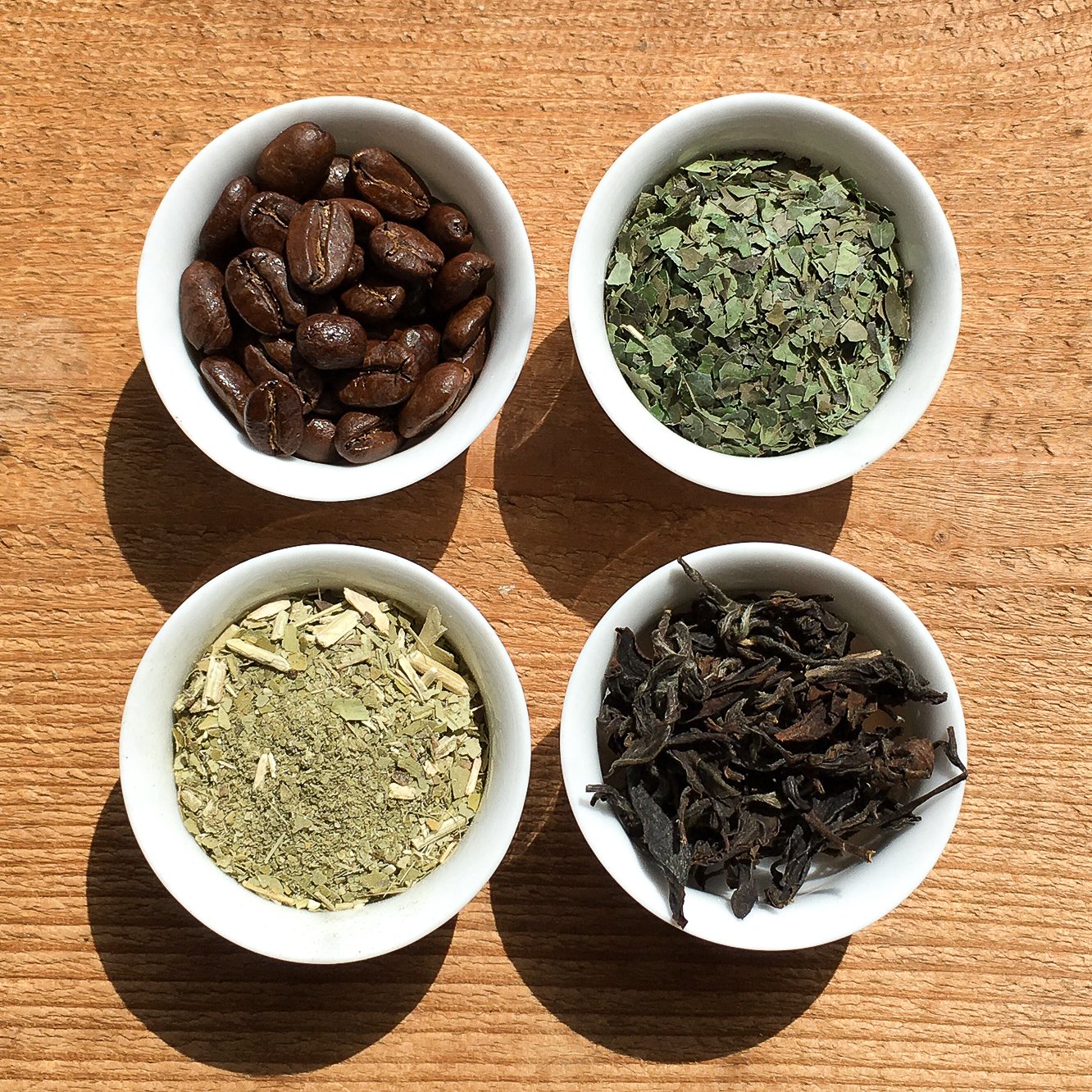6 Plants that Contain Caffeine – The Nature Energy Enhancer
Clockwise From Top Left- Coffee, Yaupon, Tea, Yerba Matte
By Sara Stewart Martinelli and Nathan Pulley
Did you know that there are number of plants that contain caffeine?
Caffeine is a natural compound found in nature that is both bitter and stimulating to the nervous and cardiovascular systems. As a chemical alkaloid, caffeine can raise mood levels and decrease fatigue, increase heart and respiratory rate, blood flow and metabolic rates. Many people feel that caffeine increases their mental clarity and provides the energy they need to get through the day. Caffeine is also a diuretic, meaning it helps the body rid itself of excess fluids, toxins, and salts by increasing urination. People of cultures around the world have used a range of plants for this energy enhancing properties.
We of course all know the two biggies:
Coffee (Coffea spp)
Probably the most well-known plant that supplies us with caffeine is coffee. The two main varietals, arabica (grown at higher elevations) and robusta (grown at lower elevations), produce little berries that are washed with the outside pulp removed, dried, roasted and ground to make the coffee that we all depend on today. These evergreen trees grow only in tropical climates between the Tropics of Cancer and Capricorn, also known as “The Bean Belt”. The main coffee producing regions of the world include, Central and South America, Central African and the Arabian Peninsula and Southeast Asia. While arabica coffee beans are more prized for their smooth and fine flavor, robusta beans contain almost twice the amount of caffeine and because of it has a more hearty and bitter flavor. 60-100mg per cup.
Tea (Camellia sinensis)
Considered one of the worlds most treasured commodities and the second most popular drink on earth (water is first), much of the history of commerce and trade routes had to do with securing tea. The same evergreen bush makes all types of tea, including black, oolong, green, white, yellow and puerh. The amount of caffeine that ends up in the final brew has many factors. Time of harvest, age of leaf, amount of tea, temperature of the water, and production style. The amount of caffeine in the final cup can range from 6 – 110 mg per cup.
But here are some that you may be less familiar with
Yaupon (Ilex vomitoria)
Yaupon is the only naturally caffeinated plant that is native to North America. It’s been enjoyed by Native Americans in the Southeast for over 8,000 years, often used in ceremony and ritual. It was believed that it purified both the mind and the body, provided strength and energy, and increased mental focus. Containing about 30% less caffeine than coffee, it provides an energetic boost without the jittery side effects of higher caffeine content beverages. It has less tannin than tea, so it cannot be over-steeped, and will not turn bitter.
Cola Nut (Cola acuminata)
Another tropical evergreen, the Cola tree produces fruits that contain the kola nut, which contains 1.25-2.4% caffeine. Originally it was these nuts that made the modern popular caffeinated and carbonated beverages that are so well-known and consumed today, though most are now made with artificial imitations. With the added sugar, these colas can offer a fast and effective energetic kick. The kola nut is still widely used in West Africa for spiritual and ceremonial purposes including religious ceremonies, ancestral honoring and significant life events such as weddings and the naming of children.
Yerba Mate (Ilex paraguariensis)
Grown in South America and a beloved plant with much history and ritual, Yerba Mate is also known as chimarrao. It is derived from a holly tree and was named by the French botanist Augustin Saint-Hilaire. The tea can be brewed either hot (mate) or cold (terere) from the holly leaves and is often sipped through a special straw out of a decorative gourd. Yerba mate contains about 10 mg of caffeine per gram. Like most herbs that do contain caffeine, Yerba Mate is known for being able to relieve fatigue, support weight loss, and alleviate the symptoms of depression. It may also help alleviate headaches.
Guarana (Paullinia cupana)
Native to Brazil and the Amazon basin, guarana seeds are about the same size as a coffee been and are considered twice as potent as coffee. Guarana is a popular herb used in modern energy drinks with each bean ranging from 2-8% caffeine. As an herbal support ally, guarana is also used to assist in weigh loss and enhance endurance and athletic performance. Guarana may help to treat low blood pressure and chronic fatigue syndrome.
So, is caffeine safe to drink? Most sources, including the FDA, say that up to 400 mg a day is safe to consume, but more than that can cause jitteriness, insomnia, increased heart rate, nausea, and headache. A good general rule and easy barometer is you know you have had too much caffeine when it doesn’t feel good. People react differently to varying amounts of caffeine, so try some of these options and see which one is just the ticket for you!

